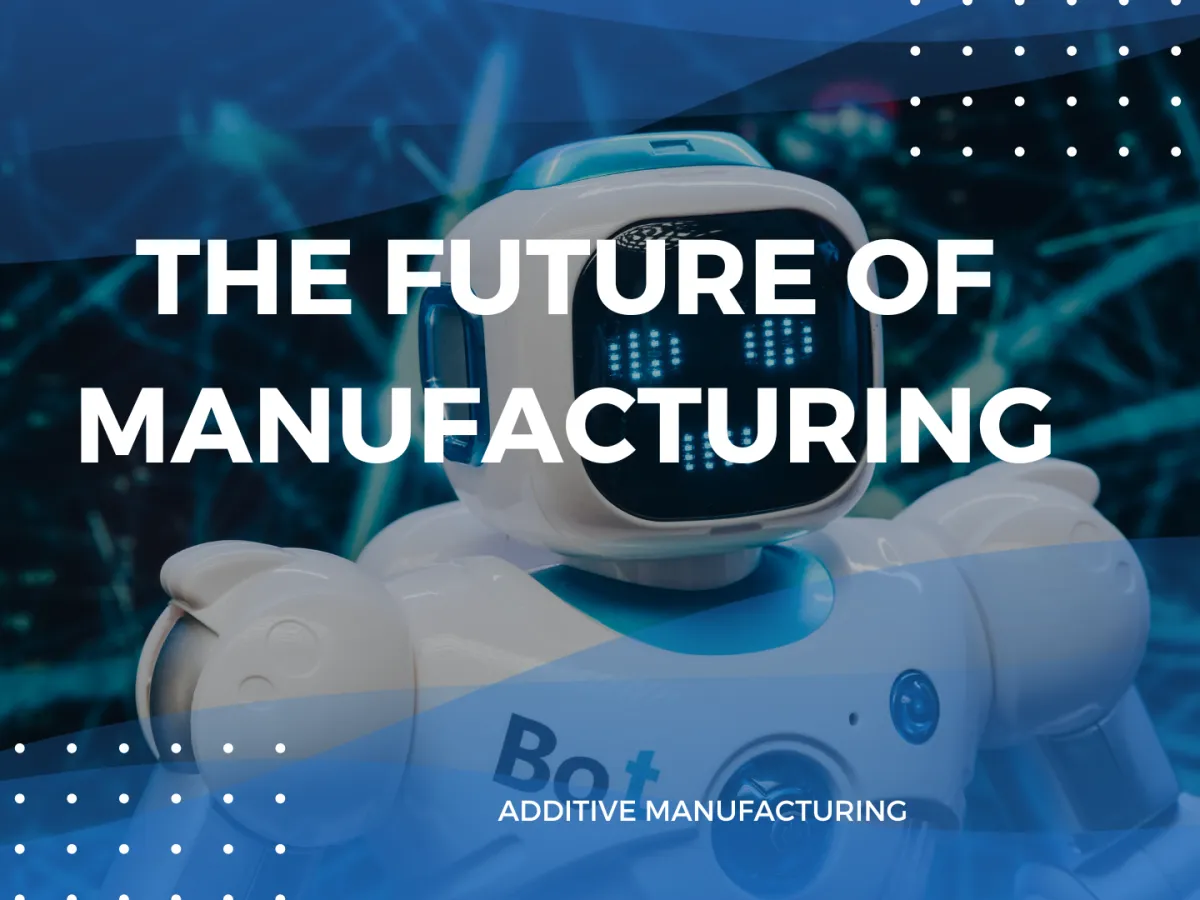Aaron's Blog
Blog Post Categories

3D Printing Evolved: The Rise of Additive Manufacturing and Its Path to Domination 🛠️🌐
“The future is already here — it's just not very evenly distributed.” - William Gibson
Introduction:
Welcome! Today we'll be delving into the fascinating advancements of 3D printing and its evolution into additive manufacturing.
The Era of 3D Printing and Its Emergence:
3D printing technology burst onto the scene in the early 1980s, sparking imaginations with its potential to transform traditional manufacturing processes. The allure of creating three-dimensional objects from a digital file was undeniable, and 3D printing quickly became synonymous with rapid prototyping.
Recent statistics reveal that the 3D printing market has been growing at an impressive compound annual growth rate (CAGR) of 26.4% since 2020 and is expected to reach $34.8 billion by 2024. However, these figures only begin to scratch the surface of what's become a much broader, more versatile field – additive manufacturing.
The Shift to Additive Manufacturing:
The term "additive manufacturing" began to emerge in the late 2000s as a way to encompass a wider array of technologies and processes beyond those typically associated with 3D printing. While 3D printing involves depositing materials layer by layer to create objects, additive manufacturing broadens this concept to include technologies like Direct Metal Laser Sintering (DMLS), Selective Laser Sintering (SLS), and Electron Beam Melting (EBM), among others.
These processes not only construct parts layer by layer, but they can also fuse materials at a granular level, offering higher precision, greater design freedom, and the ability to manufacture more complex and functional components. These advancements have begun to position additive manufacturing as a viable option for production, not just prototyping.
3D Printing in Production:
Companies worldwide are taking notice of the potential for additive manufacturing to revolutionize production. Bugatti, a pioneering automaker, provides an exemplary case of this transition. The company has begun to use additive manufacturing to produce brake calipers for its vehicles – a feat previously unheard of in the industry.
Moreover, a recent report from SmarTech Analysis predicts that revenues from additive manufacturing in the automotive industry will reach $5.3 billion by 2023. This trend is expected to continue, with additive manufacturing becoming an integral part of the manufacturing process across industries.
Applications: From Homes to Rocket Engines:
The breadth of applications for additive manufacturing is virtually limitless, spanning sectors from construction to aerospace. Companies like ICON are using additive manufacturing to construct homes, reimagining the traditional building process, and addressing housing affordability issues. On the other hand, aerospace companies, including SpaceX and Blue Origin, are using these technologies to build intricate rocket engine components, thereby enhancing performance and reducing costs.
The Future of Additive Manufacturing:
As additive manufacturing technologies continue to evolve, experts predict that it won't be long before they become the norm. With the potential to customize production runs, reduce waste, and even produce parts on demand, additive manufacturing offers a level of flexibility and efficiency that traditional manufacturing processes can't match.
According to reports by multiple analysts, the global additive manufacturing market is expected to reach between $23.9 and $50 billion by 2027, reflecting a CAGR of 14.4% during the forecast period from 2022 to 2027. This forecast further supports the notion that additive manufacturing is not only here to stay but is set to dominate the production landscape.
Preparing for the Additive Manufacturing Revolution:
As the shift from traditional manufacturing to additive manufacturing gains momentum, it's essential for businesses to adapt. They must invest in the necessary technologies and train their workforce to navigate this new manufacturing landscape successfully. Early adopters will reap the benefits of increased efficiency, reduced costs, and improved product quality.
Conclusion:
The journey from 3D printing to additive manufacturing is a testament to the power of technological evolution. What began as a novel way to create prototypes has transformed into a production powerhouse, challenging traditional manufacturing methods and opening up new avenues for innovation. As we continue to explore the potential of additive manufacturing, we can expect it to shape the future of production, promising a world where creativity meets efficiency and imagination becomes a reality.
That's all for this week's newsletter. We hope you found this information informative, and we'll be back next week with more insights and analysis on the latest trends in technology and business.
If you want to know more about additive manufacturing and how it’s a tsunami factor adding to the technology tsunami, check out my new book, “Harness The Juice,” available now on Amazon or get a free chapter at https://harnessthejuice.com

3D Printing Evolved: The Rise of Additive Manufacturing and Its Path to Domination 🛠️🌐
“The future is already here — it's just not very evenly distributed.” - William Gibson
Introduction:
Welcome! Today we'll be delving into the fascinating advancements of 3D printing and its evolution into additive manufacturing.
The Era of 3D Printing and Its Emergence:
3D printing technology burst onto the scene in the early 1980s, sparking imaginations with its potential to transform traditional manufacturing processes. The allure of creating three-dimensional objects from a digital file was undeniable, and 3D printing quickly became synonymous with rapid prototyping.
Recent statistics reveal that the 3D printing market has been growing at an impressive compound annual growth rate (CAGR) of 26.4% since 2020 and is expected to reach $34.8 billion by 2024. However, these figures only begin to scratch the surface of what's become a much broader, more versatile field – additive manufacturing.
The Shift to Additive Manufacturing:
The term "additive manufacturing" began to emerge in the late 2000s as a way to encompass a wider array of technologies and processes beyond those typically associated with 3D printing. While 3D printing involves depositing materials layer by layer to create objects, additive manufacturing broadens this concept to include technologies like Direct Metal Laser Sintering (DMLS), Selective Laser Sintering (SLS), and Electron Beam Melting (EBM), among others.
These processes not only construct parts layer by layer, but they can also fuse materials at a granular level, offering higher precision, greater design freedom, and the ability to manufacture more complex and functional components. These advancements have begun to position additive manufacturing as a viable option for production, not just prototyping.
3D Printing in Production:
Companies worldwide are taking notice of the potential for additive manufacturing to revolutionize production. Bugatti, a pioneering automaker, provides an exemplary case of this transition. The company has begun to use additive manufacturing to produce brake calipers for its vehicles – a feat previously unheard of in the industry.
Moreover, a recent report from SmarTech Analysis predicts that revenues from additive manufacturing in the automotive industry will reach $5.3 billion by 2023. This trend is expected to continue, with additive manufacturing becoming an integral part of the manufacturing process across industries.
Applications: From Homes to Rocket Engines:
The breadth of applications for additive manufacturing is virtually limitless, spanning sectors from construction to aerospace. Companies like ICON are using additive manufacturing to construct homes, reimagining the traditional building process, and addressing housing affordability issues. On the other hand, aerospace companies, including SpaceX and Blue Origin, are using these technologies to build intricate rocket engine components, thereby enhancing performance and reducing costs.
The Future of Additive Manufacturing:
As additive manufacturing technologies continue to evolve, experts predict that it won't be long before they become the norm. With the potential to customize production runs, reduce waste, and even produce parts on demand, additive manufacturing offers a level of flexibility and efficiency that traditional manufacturing processes can't match.
According to reports by multiple analysts, the global additive manufacturing market is expected to reach between $23.9 and $50 billion by 2027, reflecting a CAGR of 14.4% during the forecast period from 2022 to 2027. This forecast further supports the notion that additive manufacturing is not only here to stay but is set to dominate the production landscape.
Preparing for the Additive Manufacturing Revolution:
As the shift from traditional manufacturing to additive manufacturing gains momentum, it's essential for businesses to adapt. They must invest in the necessary technologies and train their workforce to navigate this new manufacturing landscape successfully. Early adopters will reap the benefits of increased efficiency, reduced costs, and improved product quality.
Conclusion:
The journey from 3D printing to additive manufacturing is a testament to the power of technological evolution. What began as a novel way to create prototypes has transformed into a production powerhouse, challenging traditional manufacturing methods and opening up new avenues for innovation. As we continue to explore the potential of additive manufacturing, we can expect it to shape the future of production, promising a world where creativity meets efficiency and imagination becomes a reality.
That's all for this week's newsletter. We hope you found this information informative, and we'll be back next week with more insights and analysis on the latest trends in technology and business.
If you want to know more about additive manufacturing and how it’s a tsunami factor adding to the technology tsunami, check out my new book, “Harness The Juice,” available now on Amazon or get a free chapter at https://harnessthejuice.com
Copyright 2026. All rights reserved
Testimonials

Lorem ipsum dolor sit amet, consectetur adipiscing elit, sed do eiusmod tempor incididunt ut labore et dolore magna aliqua. Ut enim ad minim veniam, quis nostrud exercitation ullamco laboris nisi ut aliquip ex ea commodo consequat.
JANE DOE

Lorem ipsum dolor sit amet, consectetur adipiscing elit, sed do eiusmod tempor incididunt ut labore et dolore magna aliqua. Ut enim ad minim veniam, quis nostrud exercitation ullamco laboris nisi ut aliquip ex ea commodo consequat.

